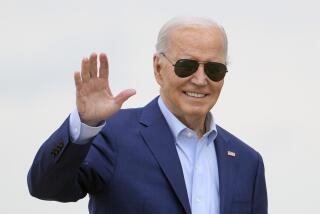Two U.S. Soldiers Killed in Afghanistan Firefight
Two U.S. soldiers were killed and a third injured Sunday in a fierce, 90-minute firefight in a rugged border region of eastern Afghanistan, the latest in a series of battles between Afghan and coalition troops and remnants of the Taliban in the group’s mountain retreats, according to the U.S. Central Command.
The Americans were on patrol near the Shkin firebase in a remote area of Paktika province when they encountered what a Central Command spokesman called “former Taliban fighters” who opened fire, wounding three soldiers. Coalition commanders dispatched a strike force and two A-10 Thunderbolt II jets to drive off the attackers, and helicopters evacuated the U.S. soldiers to Bagram air base, where two died of their wounds.
The third soldier is in stable condition, a Central Command official said. The soldiers’ names are being withheld pending notification of next of kin.
Afghan military commanders say as many as 40 Taliban were killed in the gun battle. Central Command put the number of anti-coalition dead at four.
A Central Command spokesman said Sunday’s attack was just one among nearly a dozen such incidents during the last week. The attacks did not appear to be organized and are the work of “small groups,” the spokesman said. A special operations soldier was killed in action Aug. 20 near Orgun, also in Paktika province, and another member of the special operations force was killed in Zabol province last week, Central Command said.
“This is more from us locating them than from them targeting us,” said spokesman Sgt. Maj. Lewis Matson. “The incidents have been mainly initiated by the coalition and the Afghan national army.”
The coalition and 1,000 troops from the newly trained Afghan army launched Operation Warrior Sweep in late July with a mission “to kill, capture and deny sanctuary to anti-coalition fighters and to disrupt anti-coalition activity” in targeted border regions, military commanders said at the time.
Dozens of Taliban fighters have been killed and others detained during the operation, which also has netted a vast array of weaponry from caves and other Taliban caches, Central Command said.
“There’s no question that they’ve been denied sanctuary,” Matson said. “That’s really the key element here. They don’t have the ability to assemble in mass.... It’s fire an RPG [rocket-propelled grenade] and run.”
U.S. military and Bush administration officials in Washington have downplayed recent reports from the region that the Taliban is regrouping and staging increasingly bold and deadly attacks on the U.S.-led coalition.
Air Force Lt. Gen. Norton Schwartz, the operations director for the Joint Chiefs of Staff, told reporters in mid-August that the coalition has the armed resistance on the run in Afghanistan.
“We see small elements of adversary units -- in fact, ‘unit’ is too big -- small groups of people that operate in the border area,” Schwartz said, stressing that Warrior Sweep was designed to target those groups. “And we will eliminate those elements while we continue to enable the Afghan government and the Afghan national army to assume that role on their own behalf.”
Asked how many Taliban and Al Qaeda fighters remain, Schwartz said, “I really don’t have a good estimate, but I can tell you, though, it is not a substantial number.”
Deputy Secretary of State Richard L. Armitage last week also credited the Warrior Sweep operation for “two great battles against the Taliban” that together left 35 fighters dead. He added that deploying the new Afghan army, which numbers about 5,300, is key to neutralizing the threat to U.S. and coalition forces and bringing long-term stability to the country.
“We’re training Afghan servicemen. We’re training Afghan policemen,” Armitage told a media round table. “At some point in time, they will lead, and Osama bin Laden shooting them will not be a threat to Afghanistan.”
The size of the Taliban force that attacked Sunday’s patrol near Shkin remained a mystery.
Matson, citing the recent pattern of attacks against the coalition, said, “I look at these as failed attempts by a defeated group that doesn’t want to give up the ghost.”
Since the start of the U.S.-led combat operations against the Taliban and Al Qaeda in Afghanistan, 35 coalition troops have been killed in action and 34 more have died in accidents and other incidents the Pentagon calls “nonhostile” acts. The majority of the dead are Americans, Matson said.
There are now about 10,000 U.S. troops in Afghanistan in a coalition force of about 12,500.
More to Read
Start your day right
Sign up for Essential California for news, features and recommendations from the L.A. Times and beyond in your inbox six days a week.
You may occasionally receive promotional content from the Los Angeles Times.






